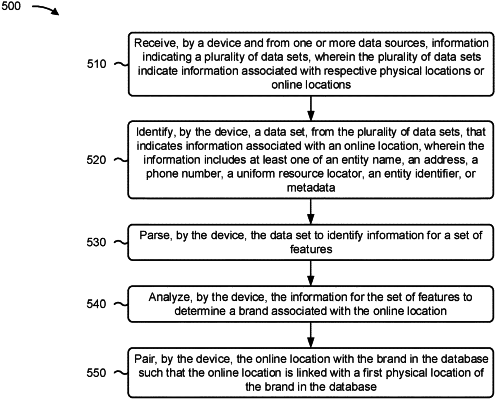| CPC G06Q 30/0201 (2013.01) [G06F 16/288 (2019.01); G06F 16/29 (2019.01); G06N 5/04 (2013.01); G06N 20/00 (2019.01)] | 20 Claims |

|
1. A system for linking physical location data and online channel data of entities in a database, the system comprising:
one or more memories; and
one or more processors, communicatively coupled to the one or more memories, configured to:
receive information associated with a plurality of locations,
wherein the plurality of locations include at least one in-person location and at least one online location;
identify, from the plurality of locations, candidate locations;
parse information associated with the candidate locations to identify information for a set of features for the candidate locations,
wherein the set of features includes at least one of a name, a phone number, a geographic location, a uniform resource locator, a headquarters address, an entity category, metadata, or transaction data, and
wherein parsing the information comprises:
identifying the set of features by obtaining the set of features from structured data by performing natural language processing to extract the set of features from unstructured data;
iteratively training a machine training model, comprising at least one of a neural network or a support vector, to generate a trained machine learning model,
wherein the trained machine learning model is trained using the set of features;
apply the trained machine learning model to the information for the set of features for the candidate locations;
determine, based on applying the trained machine learning model, that a score associated with an output of the trained machine learning model satisfies a threshold,
wherein the score indicates a likelihood that the candidate locations are associated with a same entity;
determine, based on the score, whether the candidate locations are associated with the entity; and
add information associated with the candidate locations to a graph associated with the entity if the candidate locations are associated with the same entity;
receive a request to generate one or more temporary credentials associated with the entity;
identify, based on the graph, at least one online location and at least one physical location associated with the entity; and
generate, based on identifying the at least one online location and the at least one physical location associated with the entity, the one or more temporary credentials,
wherein the one or more temporary credentials are enabled to complete one or more transactions at the at least one online location and the at least one physical location.
|